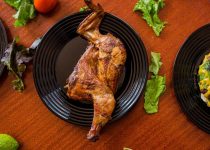Chef-Approved Safety Guidelines for Outdoor Cooking
Are you ready to grill up a delicious meal in the great outdoors? Before you fire up the grill, it’s important to follow some chef-approved safety guidelines.
In this article, we’ll show you how to properly handle raw meat, control fire hazards, ensure food is cooked to safe temperatures, prevent cross-contamination, and use grilling equipment safely.
Plus, we’ll share some tips for safely storing your outdoor food.
Let’s get cooking, safely!
Table of Contents
Properly Handling Raw Meat
To ensure food safety, always prioritize the proper handling of raw meat when cooking outdoors. This is crucial to prevent the risk of foodborne illnesses and maintain the health of yourself and your guests.
Begin by thoroughly washing your hands with soap and warm water before and after handling raw meat. This simple step helps eliminate any harmful bacteria that may be present.
Additionally, keep raw meat separate from other foods to avoid cross-contamination. Use separate cutting boards, utensils, and plates for raw meat and ready-to-eat food.
It’s also important to refrigerate raw meat promptly and store it in a leak-proof container to prevent any potential contamination. When marinating meat, do it in the refrigerator, not on the counter. And always discard any leftover marinade that came into contact with raw meat.
Finally, cook meat thoroughly, ensuring it reaches the recommended internal temperature to kill any harmful bacteria.
Controlling Fire Hazards
Now let’s talk about controlling fire hazards when cooking outdoors.
To ensure safety, make sure to handle fuel properly, keeping it away from open flames and in a secure location.
Additionally, it’s important to have fire extinguishers readily accessible and positioned in areas where they can be easily reached in case of an emergency.
Lastly, always be mindful of the proper positioning of your grill to avoid any potential fire hazards.
Safe Fuel Handling
Handle fuel safely to control fire hazards when cooking outdoors. To ensure your safety, follow these guidelines:
-
Choose the right fuel: Use only fuels designed for outdoor cooking, such as charcoal, propane, or natural gas. Avoid using gasoline, kerosene, or other flammable liquids as they can lead to dangerous situations.
-
Store fuel properly: Keep fuel containers tightly sealed and away from heat sources. Store them in a well-ventilated, cool area, away from children and pets.
-
Handle fuel with care: Always follow the manufacturer’s instructions when handling and storing fuel. Use a funnel to pour fuel into your cooking equipment to avoid spills. Never add fuel to a lit or hot fire.
-
Extinguish fires safely: When you’re done cooking, make sure to fully extinguish the fire. Close all vents and lids to cut off the oxygen supply. Dispose of ashes in a metal container and keep it away from combustible materials.
Fire Extinguisher Placement
Ensure the effective control of fire hazards by placing a fire extinguisher in a readily accessible location.
When it comes to outdoor cooking, having a fire extinguisher nearby is crucial for your safety. You never know when a small fire can turn into a big one, so it’s important to be prepared. Make sure the fire extinguisher is placed in a location where it can be easily reached in case of an emergency. Ideally, it should be within arm’s reach of the cooking area and in a spot that’s visible and easily identifiable.
Additionally, ensure that everyone in your cooking area knows where the fire extinguisher is located and how to use it properly. By following these guidelines, you can effectively control fire hazards and ensure a safe outdoor cooking experience.
Proper Grill Positioning
Place your grill in a strategic position to effectively control fire hazards while continuing to cook outdoors. Here are four important guidelines to follow:
-
Distance: Keep your grill at least 10 feet away from any structures or flammable materials. This includes your home, deck, trees, and bushes. Creating a safe distance ensures that any potential fire incidents are contained and don’t spread.
-
Level ground: Position your grill on a stable and level surface. This will prevent it from tipping over and causing accidents or fires. Avoid placing it on uneven ground or areas prone to strong winds.
-
Ventilation: Make sure your grill has proper ventilation. This allows for the proper flow of air and reduces the risk of flare-ups. Avoid placing your grill in enclosed or tight spaces.
-
Overhead hazards: Be mindful of any overhead hazards such as awnings, branches, or power lines. Ensure that there’s enough clearance above your grill to prevent any accidents or fire hazards.
Ensuring Food Is Cooked to Safe Temperatures
To ensure that your food is cooked to safe temperatures, there are two key points to consider.
First, use temperature monitoring methods such as a meat thermometer to accurately gauge the internal temperature of your food.
Second, follow cooking time recommendations provided by professional chefs to ensure that your food is cooked thoroughly.
Temperature Monitoring Methods
You can accurately monitor the temperature of your food to ensure it’s cooked safely using various methods. Here are four temperature monitoring techniques that chefs recommend:
-
Instant-Read Thermometer: This handy tool provides quick and accurate readings by inserting the probe into the thickest part of the food.
-
Oven Thermometer: Place this thermometer inside the oven to verify its temperature, as oven dials aren’t always accurate.
-
Remote Meat Thermometer: Perfect for larger cuts of meat, this thermometer allows you to monitor the temperature from a distance using a wireless receiver.
-
Probe Thermometer: This type of thermometer remains in the food throughout the cooking process and provides continuous temperature readings.
Cooking Time Recommendations
To ensure your food is cooked to safe temperatures, follow these chef-approved cooking time recommendations. Cooking times can vary depending on the type of food you’re preparing.
For example, chicken should be cooked until the internal temperature reaches 165°F (74°C), while hamburgers should reach 160°F (71°C). Fish, on the other hand, should be cooked until it reaches an internal temperature of 145°F (63°C).
It’s important to use a food thermometer to accurately measure the temperature of your food. Remember to insert the thermometer into the thickest part of the meat, away from the bone.
Preventing Cross-Contamination
Proper food handling techniques are essential for preventing cross-contamination during outdoor cooking. It’s crucial to take necessary precautions to ensure the safety of your food and protect yourself and your guests from potential foodborne illnesses. Here are four important guidelines to follow:
-
Separate raw and cooked foods: Keep raw meats, poultry, and seafood separate from cooked foods to prevent cross-contamination. Use separate cutting boards, utensils, and plates to avoid any contact between raw and cooked items.
-
Wash hands frequently: Regularly wash your hands with soap and water for at least 20 seconds. This is especially important when handling raw meats or touching surfaces that may have come into contact with raw food.
-
Use separate marinades and sauces: Don’t reuse marinades or sauces that have come into contact with raw meat, as they can contain harmful bacteria. Always discard any leftover marinades or sauces used on raw food.
-
Cook food to the correct temperature: Use a food thermometer to ensure that your food has reached the appropriate internal temperature. This will help kill any bacteria present and reduce the risk of foodborne illnesses.
By following these simple yet important guidelines, you can minimize the risk of cross-contamination and enjoy safe and delicious outdoor cooking experiences.
Safe Use of Grilling Equipment
When operating grilling equipment, it is important to carefully follow safety guidelines. Grilling can be a fun and delicious way to cook outdoors, but it also comes with potential risks. By taking the necessary precautions, you can ensure a safe grilling experience for yourself and those around you. Here are some essential safety tips to keep in mind:
| Safety Tip | Explanation |
|---|---|
| Choose a safe location | Place your grill on a level surface away from flammable materials such as trees or buildings. |
| Check for gas leaks | Before lighting the grill, inspect the gas hose for any leaks by applying a solution of soap and water. Bubbles will indicate a leak. |
| Keep a fire extinguisher nearby | In case of emergencies, have a fire extinguisher within reach and know how to use it properly. |
| Practice safe handling | Use long-handled utensils to minimize the risk of burns, and always wear heat-resistant gloves when handling hot grates or surfaces. |
Tips for Safe Outdoor Food Storage
When grilling outdoors, it’s important to store your food safely to prevent any contamination or spoilage. Here are four essential tips to ensure the safety of your outdoor food storage:
-
Keep raw and cooked foods separate: Store raw meats, poultry, and seafood in sealed containers or plastic bags to prevent their juices from dripping onto other foods. This will help avoid cross-contamination and the spread of harmful bacteria.
-
Use a cooler for perishable items: If you’re planning on bringing perishable foods, like salads or dairy-based desserts, to your outdoor gathering, make sure to store them in a cooler with plenty of ice or ice packs. This will help maintain the proper temperature and prevent bacterial growth.
-
Label and date your leftovers: If you have any leftover food from your outdoor grilling session, make sure to label and date the containers. This will help you keep track of how long the food has been stored and ensure that you consume it before it spoils.
-
Follow the ‘two-hour rule’: Remember to follow the ‘two-hour rule’ when it comes to leaving food out at room temperature. Perishable items shouldn’t be left out for more than two hours, or one hour if the outdoor temperature is above 90°F (32°C). After this time, bacteria can multiply rapidly and cause foodborne illnesses.
Frequently Asked Questions
How Do I Know if the Meat Is Cooked to a Safe Temperature Without Using a Meat Thermometer?
If you don’t have a meat thermometer, there are other ways to check if the meat is cooked safely. One way is to use the touch test, where you press the meat and check its firmness.
Can I Reuse the Same Plate That Held Raw Meat Without Washing It First?
No, you shouldn’t reuse the same plate that held raw meat without washing it first. This can lead to cross-contamination and increase the risk of foodborne illnesses. Always prioritize food safety and cleanliness.
What Are Some Common Fire Hazards to Watch Out for When Grilling Outdoors?
When grilling outdoors, common fire hazards to watch out for include leaving the grill unattended, using flammable materials near the grill, and not properly cleaning grease buildup. Always prioritize safety!
Is It Safe to Marinate Meat at Room Temperature Before Grilling?
It’s not safe to marinate meat at room temperature before grilling. Bacteria can multiply rapidly at room temperature, increasing the risk of foodborne illnesses. Always marinate meat in the refrigerator to keep it safe.
What Are Some Safety Precautions to Take When Using Charcoal Grills?
To ensure your safety when using charcoal grills, remember to place the grill in a well-ventilated area, keep a fire extinguisher nearby, and never leave it unattended. Follow these guidelines to avoid accidents.



